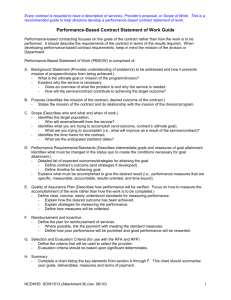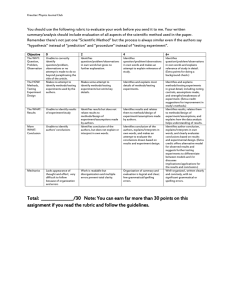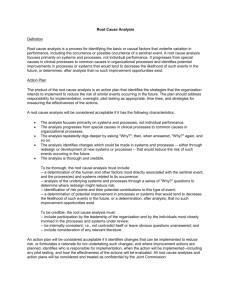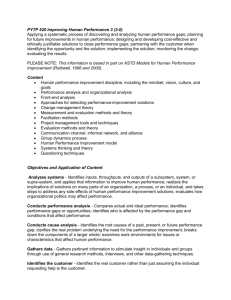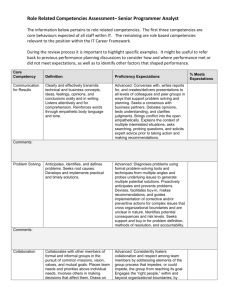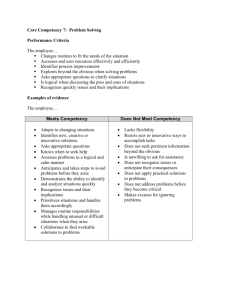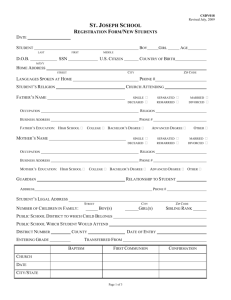High School Biology MCAS Performance Level Descriptors
advertisement
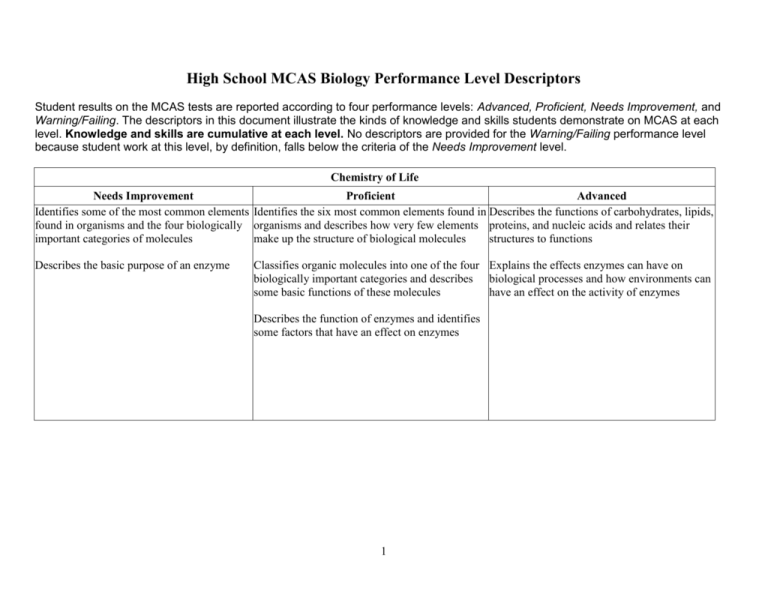
High School MCAS Biology Performance Level Descriptors Student results on the MCAS tests are reported according to four performance levels: Advanced, Proficient, Needs Improvement, and Warning/Failing. The descriptors in this document illustrate the kinds of knowledge and skills students demonstrate on MCAS at each level. Knowledge and skills are cumulative at each level. No descriptors are provided for the Warning/Failing performance level because student work at this level, by definition, falls below the criteria of the Needs Improvement level. Chemistry of Life Needs Improvement Proficient Advanced Identifies some of the most common elements Identifies the six most common elements found in Describes the functions of carbohydrates, lipids, found in organisms and the four biologically organisms and describes how very few elements proteins, and nucleic acids and relates their important categories of molecules make up the structure of biological molecules structures to functions Describes the basic purpose of an enzyme Classifies organic molecules into one of the four Explains the effects enzymes can have on biologically important categories and describes biological processes and how environments can some basic functions of these molecules have an effect on the activity of enzymes Describes the function of enzymes and identifies some factors that have an effect on enzymes 1 Cell Biology Needs Improvement Identifies most cell parts/organelles and describes some of their functions Proficient Describes the functions of organelles within the cell and describes various forms of cell membrane transport Recognizes the basic difference between diffusion (no energy required) and active transport (energy required) Advanced Describes the makeup of a cell membrane and explains its role as a highly selective barrier Explains the classification of organisms based on cellular evidence and modes of nutrition Describes general characteristics of prokaryotes and eukaryotes and describes how organisms are grouped into kingdoms Explains the relationship between Identifies examples of organisms within most photosynthesis and cellular respiration and of the kingdoms and classifies them as Differentiates between photosynthesis and writes equations for each reaction prokaryotic or eukaryotic cellular respiration; identifies their reactants and products Compares and contrasts meiosis and mitosis, Identifies the basic purposes of photosynthesis including their roles in growth and reproduction and cellular respiration and identifies their Describes how mitosis is a primary means of products reproduction in asexual organisms and is also Explains how viruses differ from cellular used in growth/repair of cells; describes how the organisms in structure, function, and Identifies examples of mitosis and meiosis; purpose of meiosis is to produce sex cells with reproductive machinery distinguishes between sexual reproduction half the genetic material and asexual reproduction Describes the process of fertilization and its Recognizes that gametes are involved in products fertilization and that zygotes are a result of this process Describes the general structure and reproductive process for viruses Recognizes that viruses are unable to reproduce without a host cell 2 Genetics Needs Improvement Proficient Identifies the basic structure (double helix, Describes the basic structure of DNA and its sugar/phosphate backbone, linked by function in genetic inheritance, and describes the complementary nucleotide pairs) of DNA and semi-conservative nature of DNA replication; describes DNA as a carrier of genetic describes the flow of information from DNA to information in organisms RNA to protein Identifies basic purposes of replication, transcription, and translation Identifies processes that can lead to genetic mutations and recognizes that mutations may or may not result in phenotypic change Identifies examples of genetic mutations Identifies different inheritance patterns Distinguishes between dominant and recessive traits and completes partial Punnett squares Distinguishes between Mendel's laws of for monohybrid crosses segregation and independent assortment Identifies examples of segregation and independent assortment Produces Punnett squares and calculates genotype and phenotype ratios for monohybrid crosses 3 Advanced Explains how the physical structure of DNA relates to its replication and explains the processes of transcription and translation and the resulting expression of genes Explains how a mutation may or may not result in a phenotypic change Describes how various inheritance patterns can affect offspring produced from a given genetic cross Describes how independent assortment and segregation can be observed through different types of crosses Needs Improvement Identifies most of the major organs and structures of the digestive, circulatory, respiratory, nervous, and muscular/skeletal systems, and relates some structures to function Anatomy and Physiology Proficient Describes functions of major organs and structures of the digestive, circulatory, respiratory, nervous, and muscular/skeletal systems and describes basic functions of the kidneys and liver Recognizes that sexual reproduction produces Explains why offspring produced from sexual offspring composed of genetic information reproduction will resemble the parents, but will from both parents not be identical to the parents Identifies examples of homeostasis Describes different ways that cells can communicate Identifies the importance of the nervous and endocrine systems in cellular communication Identifies various ways the body maintains homeostasis and recognizes a feedback loop 4 Advanced Describes overall functions of the digestive, circulatory, respiratory, nervous, and muscular/skeletal systems with major organs/structures and functions of those organs/structures; describes how the kidneys and liver are associated with the circulatory system Relates cell communication to types of cells and their functions Explains various ways the body maintains homeostasis and describes the function of a feedback loop Needs Improvement Identifies various types of evidence that demonstrate evolution Describes species as reproductively distinct groups of organisms Evolution and Biodiversity Proficient Describes how various types of evidence demonstrate evolution; interprets diagrams that show the evolution of organisms Advanced Analyzes situations relating to evolution through natural selection and uses evidence from the fossil record, molecular biology, etc., to demonstrate changes in biodiversity over Describes the hierarchical relationships within the time taxonomic system Lists the taxonomic hierarchy from kingdom to species Describes various conditions that could lead to speciation within a population Recognizes that favorable traits will allow certain individuals in a population to survive Describes how a natural selection process could and reproduce better than others affect the genetic diversity of a population 5 Ecology Needs Improvement Proficient Identifies that birth and immigration increase Describes how various events and conditions population size, while death and emigration could affect population size or biodiversity decrease it Describes how multiple factors may interact to Identifies factors that influence population affect population size or biodiversity size or biodiversity Explains energy relationships among members of Identifies the correct trophic level for a a food web member of a food web Describes how various biotic and abiotic Identifies the relationship between two processes (photosynthesis, evaporation, nitrogen organisms in an ecosystem fixation, etc.) help maintain nutrient cycles Describes basic nutrient cycles and can identify some components of a cycle 6 Advanced Solves complex problems relating to population size and biodiversity; analyzes multiple factors (natural phenomena, human intervention, interorganism relationships, etc.) and interprets and/or creates energy pyramids and food webs Explains relationships among various nutrient cycles
